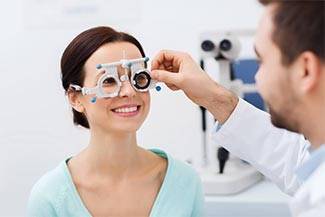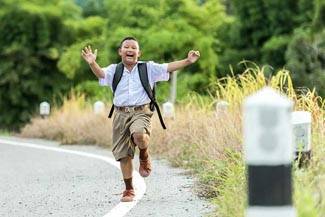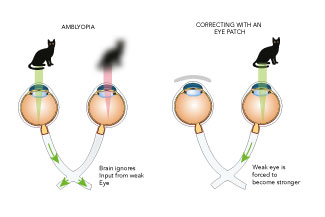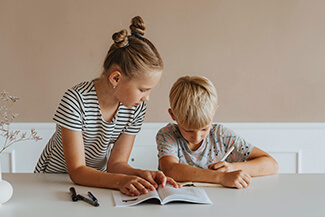
Vision Therapy Can Improve Reading Skills In Children
Because 75% to 90% of what a child learns enters through their eyes and travels down the visual pathways to the brain, it stands to reason that any obstruction in their visual system may keep a child from achieving their full potential.
If your child struggles to read, it may be rooted in an undetected visual dysfunction. To read seamlessly, one needs to possess strong vision skills, such as excellent binocular vision, visual fixation, saccades, accommodation, and convergence. As mentioned above, a deficiency in any of these visual functions can result in reading difficulties, which, in turn, hinders learning and academic success.
Fortunately, the vision therapy program offered at Eye Health Centre can help improve your child’s visual skills, thus improving his or her reading abilities and scholastic achievements. Call us to set up a functional vision evaluation with to assess your child's visual skills.
The Difference Between Good Eyesight and Good Vision
Basic vision screenings offered in schools only check for visual acuity — meaning, how clearly your child can see objects situated 20 feet away. This is usually referred to as 20/20 eyesight. However, 20/20 eyesight doesn’t mean that the child has perfect vision. Children may have 20/20 eyesight, with or without prescription glasses and may still experience trouble reading, learning or seeing the board due to reduced visual skills.
Which Visual Skills are Necessary For Reading and Learning?
-
 Visual fixation - the eye's ability to aim accurately at a given target. Static fixation refers to the eye’s ability to aim and focus on a stationary object, such as a word on a page. Whereas saccadic fixation is when the eyes move rapidly and accurately across a page to read a line of print.
Visual fixation - the eye's ability to aim accurately at a given target. Static fixation refers to the eye’s ability to aim and focus on a stationary object, such as a word on a page. Whereas saccadic fixation is when the eyes move rapidly and accurately across a page to read a line of print. - Accommodation - is when the eyes adjust their focus as the distance between the individual and the target shifts from near to far. One's ability to maintain focus at near distances is critical for reading and writing.
- Binocular fusion - the brain’s ability to form a single, integrated image with the information received by each individual eye. Poor binocular vision tends to result in double or blurred vision, confusion, or reading avoidance.
- Saccades - rapid eye movements, such as when the eyes move from one word to the next when reading a text.
- Convergence - the eyes’ ability to turn towards each other to maintain a single image, which is vital for reading.
How Can Parents and Teachers Spot a Child's Visual Dysfunction?
Detecting a visual problem can be difficult — especially in children — as they may not complain about their vision, or simply lack the verbal skills to effectively communicate what they’re experiencing. By undergoing a functional vision assessment with Dr. Sophie Jobin, the optometrist will determine whether visual dysfunction is at the root of their difficulty. In addition to reading problems, poor visual skills can manifest in several ways:
- Children with reading difficulties may exhibit behavioral issues associated with frustration
- Reading below school grade level
- Excessive fidgeting or low attention span could indicate a vision-related problem
- They may resist going to school or doing homework
- In the classroom, they may shy away from reading out loud or avoid reading altogether
- They may struggle to summarize or remember what they’ve just read
- Teachers may notice the child taking frequent bathroom breaks during reading-related activities
- When looking at distant objects, such as a blackboard, they may cover one eye, tilt their head, or frequently blink their eyes
If you notice a child displaying any of the above behaviors, it may be time to call Eye Health Centre for a functional vision evaluation.
How Does Vision Therapy Improve Reading Skills?
 Vision is a learned skill — meaning, it can be trained and often responds well to training due to the brain’s neuroplasticity. In fact, a study published in the Journal of Learning Disabilities found that 12 vision therapy sessions significantly enhanced reading abilities among sixth graders with subpar reading levels. Results indicate that after undergoing vision therapy, their attention processing abilities and reading improved by an impressive 220%.
Vision is a learned skill — meaning, it can be trained and often responds well to training due to the brain’s neuroplasticity. In fact, a study published in the Journal of Learning Disabilities found that 12 vision therapy sessions significantly enhanced reading abilities among sixth graders with subpar reading levels. Results indicate that after undergoing vision therapy, their attention processing abilities and reading improved by an impressive 220%.
The vision therapy program offered at Eye Health Centre can provide similar outcomes for your child. If visual dysfunction is the underlying cause of your child's reading and learning struggles, our tailor-made vision therapy program will target and improve his or her specific visual skills. The process may involve various aids and tools, such as prisms, filters, eye patches, balance beams, and digital simulations.
Because reading issues can have multiple causes, a multidisciplinary approach incorporating other health care professionals and educators will help ensure that your child reads at the expected level.
If you suspect that a vision problem may be preventing your child from reaching his or her potential, contact Eye Health Centre to schedule a functional eye evaluation today. Invest in your child’s future with vision therapy and see the results for yourself.
Dr. Sophie Jobin provides vision therapy and other services to patients from St. Albert, Edmonton, Spruce Grove, Fort Saskatchewan, and throughout Alberta.
References
- AOA - Resources for teachers
- Vision Help - Vision & Learning Library
- Learning-Related Vision Problems
- 11 Characteristics Of Struggling Readers
- School-Aged Vision: 6 to 18 Years of Age
Our Vision Therapy Services:
- Children often struggle with learning and sports as a result of undiagnosed vision problems — most commonly Convergence Insufficiency (CI). CI has been shown to affect a child’s reading ability, attention and overall school performance. Learn how vision therapy can treat this condition thereby leading to more success in school, work and in sports.
- Good vision is essential for a student of any age to reach his full potential and find success in the school setting.
- Amblyopia or “lazy eye” is a neuro-developmental vision condition that begins in early childhood. Strabismus, also known as an “eye turn” or “cross-eye”, is a condition characterized by the improper alignment of the eyes.
- Children with undetected vision problems can struggle with reading and writing, which can adversely affects their studies and quality of life. Read on to find out the ways a developmental optometrist can help.
- Children with special needs are more prone to developing vision problems than the general population. These visual deficits often hamper their academic achievements. Read on to learn how vision therapy can help these children achieve their full potential.
- Just because someone has 20/20 vision, doesn't mean that they can see well. A large percentage of students pass vision screenings with flying colors, yet still experience serious functional vision issues impacting development, life functions and learning. Only a Functional Vision Exam can evaluate whether all essential visual skills are working correctly.
- Amblyopia, commonly referred to as Lazy Eye, occurs when the brain and the eye are not working in unison, resulting in decreased vision in an eye that otherwise seems healthy. The only treatment available which treats the amblyopia and not just the symptoms is Vision Therapy, also called Development Optometry.
- Good vision is so much more than 20/20. A vision screening measures visual acuity only but does not uncover vision deficiencies, such as poor focus or tracking problems, convergence insufficiency, and other essential functional vision skills. These can have a profound effect on your child’s learning abilities and overall success in life.
- Keep Up-To-Date with our Vision Therapy Blog!
- Meniere’s disease, a vestibular problem, can be exacerbated by issues related to the visual system. Vision therapy can help reduce dizziness related to visual dysfunction and offer some relief to patients suffering from Meniere’s disease.
- Those with Down syndrome (DS) can experience a range of visual problems and disorders, and can be at risk of developing vision-robbing ocular diseases, such as glaucoma. Read on to learn more and find out how vision therapy can help.
- Poor visual skills can affect many areas of life and can negatively impact performance at school, the office and on the sports field. Read on to find out the most common visual efficiency problems, and how vision therapy can help.
- Vision therapy helps strengthen the connection between the eyes, brain and body with prescribed at-home and in-office eye exercises.












